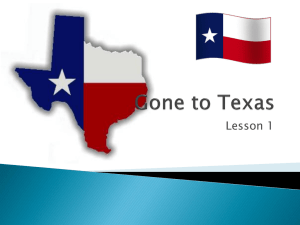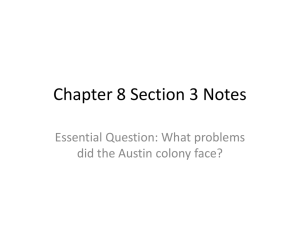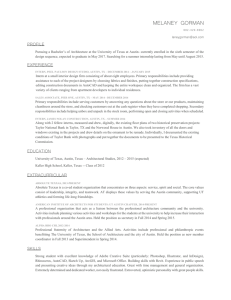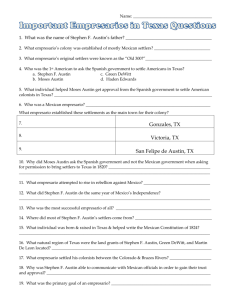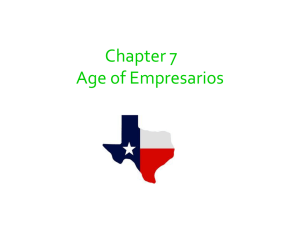Chapter 7 Notes - Killeen Independent School District
advertisement
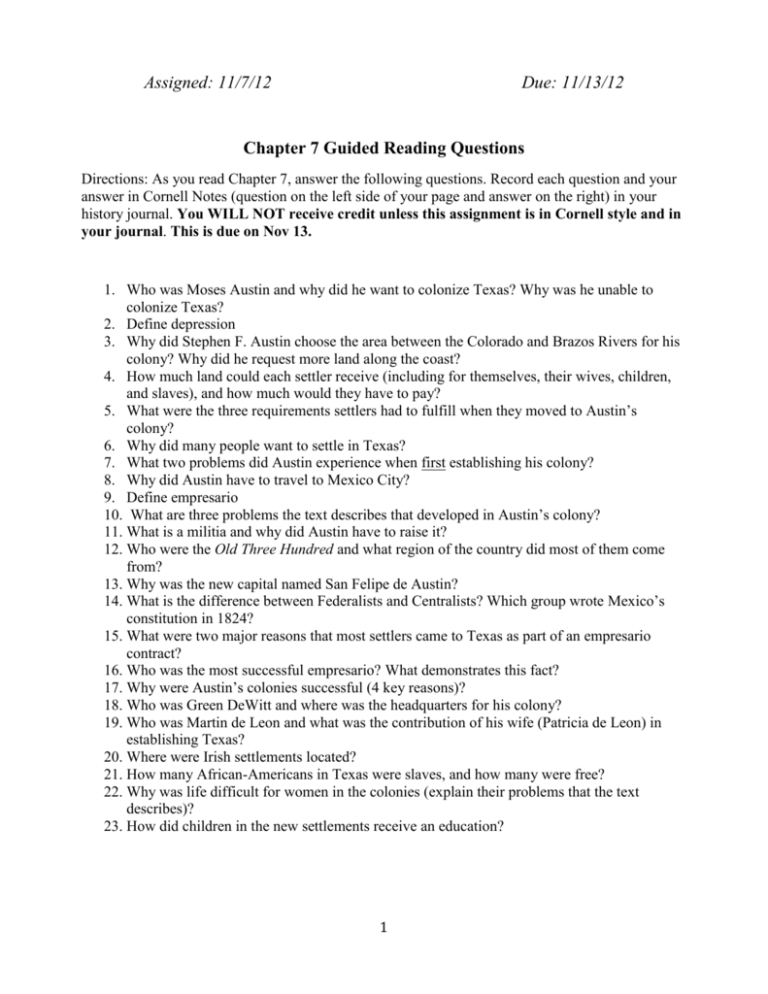
Assigned: 11/7/12 Due: 11/13/12 Chapter 7 Guided Reading Questions Directions: As you read Chapter 7, answer the following questions. Record each question and your answer in Cornell Notes (question on the left side of your page and answer on the right) in your history journal. You WILL NOT receive credit unless this assignment is in Cornell style and in your journal. This is due on Nov 13. 11 1. Who was Moses Austin and why did he want to colonize Texas? Why was he unable to colonize Texas? 2. Define depression 3. Why did Stephen F. Austin choose the area between the Colorado and Brazos Rivers for his colony? Why did he request more land along the coast? 4. How much land could each settler receive (including for themselves, their wives, children, and slaves), and how much would they have to pay? 5. What were the three requirements settlers had to fulfill when they moved to Austin’s colony? 6. Why did many people want to settle in Texas? 7. What two problems did Austin experience when first establishing his colony? 8. Why did Austin have to travel to Mexico City? 9. Define empresario 10. What are three problems the text describes that developed in Austin’s colony? 11. What is a militia and why did Austin have to raise it? 12. Who were the Old Three Hundred and what region of the country did most of them come from? 13. Why was the new capital named San Felipe de Austin? 14. What is the difference between Federalists and Centralists? Which group wrote Mexico’s constitution in 1824? 15. What were two major reasons that most settlers came to Texas as part of an empresario contract? 16. Who was the most successful empresario? What demonstrates this fact? 17. Why were Austin’s colonies successful (4 key reasons)? 18. Who was Green DeWitt and where was the headquarters for his colony? 19. Who was Martin de Leon and what was the contribution of his wife (Patricia de Leon) in establishing Texas? 20. Where were Irish settlements located? 21. How many African-Americans in Texas were slaves, and how many were free? 22. Why was life difficult for women in the colonies (explain their problems that the text describes)? 23. How did children in the new settlements receive an education? 24. 11111r 1 Chapter 7-1: Austin Establishes a Colony Moses Austin Paves the Way Moses Austin moved from Connecticut in 1798 to what is now Missouri. At that time, Missouri still belonged to Spain. At first, Moses Austin was very successful. However, in 1819, a depression in the United States ruined his business. A depression is a time in which money loses value and people lose jobs. He wanted to regain his fortune, and decided to talk to the Spanish governor about colonizing Texas. In 1820 Austin and an enslaved African American named Richmond left for Texas. With the help of Baron de Bastrop, Austin convinced Governor Antonio Martínez to allow 300 American families to settle in Texas. Before Austin could carry out his plans, he became ill with pneumonia and died. He wanted his son to carry out his plans. Stephen F. Austin Continues His Father’s Work Stephen F. Austin was on his way to help his father set up the colony in June of 1821 when Moses Austin died. Stephen had been studying law and working for a newspaper in New Orleans. Stephen F. Austin was determined to carry out his father’s plan. He went to see Governor Martínez. Governor Martínez welcomed him and discussed plans for settlement. Austin Sets Colony Boundaries Austin decided that the region between the Colorado and the Brazos Rivers was a good place for a colony. It had good soil, plenty of water, natural resources, a mild climate, and no other settlements. Austin wrote a full report to Governor Martínez outlining the boundaries he wanted for his colony. He also requested more land along the coast. He knew he would need a port where settlers could land and get supplies. Advertising for Colonists Austin advertised for settlers to come to his colony. Every man would receive 640 acres for himself, 320 acres for his wife, 160 acres for each child, and 80 acres for each slave. Austin surveyed, or measured, the land himself to decide on grant sizes and boundaries. Settlers would pay him 12.5 cents per acre. Austin would use the money to do the surveys. He also used the money to advertise for new settlers, prepare the titles, and register the grants. Austin gave the settlers credit, giving them time to pay. Settlers coming to Texas had to become citizens of Mexico. They also had to become Catholic and have good morals. Good Land and Low Prices Attract Settlers Many people wanted to settle in Texas because it had good farmland at low prices. In November 1821, Austin purchased a ship called the Lively to take people and supplies from New Orleans to the new colony. Austin began to have problems. In February 1822, the Lively wrecked on Galveston Island. Many colonists and badly needed supplies were lost. In March 1822, Austin learned that Mexico had won its independence from Spain. The new government did not recognize Austin’s right to colonize Texas. Governor Martínez told Austin to travel to Mexico City. He would need to get approval from the new government. Austin Impresses Mexican Leaders After spending more than a year in Mexico City, Austin was given a contract for colonization of Texas. Under this new contract in 1823, the amount of land each settler received was more than that granted by Governor Martínez. Families who raised livestock and farmed could receive 4,605 acres. 2 Austin would get 100,000 acres of land for his services as empresario, or land agent. He would still be able to settle 300 families. Problems Develop in the Colony Many problems developed in the colony. Some colonists left Texas because of drought. Others needed their land to be surveyed. People disagreed over land ownership. Austin and Baron de Bastrop, the land commissioner, settled claims to the land. Native Americans did not like the colonists on their territory. The Karankawas and Tonkawas raided settlements and stole livestock. Austin had to raise a militia for protection. A militia is a temporary army unit. Soon, relations between the settlers and the Native Americans became quiet. Men and Women of the Old Three Hundred By 1825, Austin had given land to nearly 300 families. The settlers in the colony became known as the Old Three Hundred. Most had come from Alabama, Arkansas, Louisiana, Missouri, and Tennessee. They chose the best land for their homes and farms. Several members of the Old Three Hundred had been in Texas before Austin. Jane Long held a land title on the lower Brazos River. R. M. Williamsom, a lawyer, became a leader in the Texas independence movement. Some women received land of their own. Rebekah Cummings came to Texas with her children. Nancy Spencer and Elizabeth Tumlinson stayed in Texas and became members of the Old Three Hundred after Native Americans killed their husbands. The Colony Gets a Capital The colony was growing and needed a capital. Austin thought the west bank of the Brazos River would be a good place. The town was named San Felipe de Austin in honor of both Austin and the patron saint of Texas Governor Luciano Garcia. In 1827, San Felipe became the capital for about 200 people. Chapter 7-2: The Colonies Grow The Constitution of 1824 In March 1823, the emperor of Mexico was overthrown. Federalists formed the new government. Federalists believed in sharing power between states and the national government. Their rivals, the Centralists, believed that power should be in the central government of Mexico City. The Federalists wrote a constitution for Mexico in 1824. Mexico Passes Colonization Law The congress in Mexico City passed a colonization law in 1824. It said the Mexican states were in charge of working out their own plans for settlement. The federal government limited how much land a settler could receive. It stated where a colony could be established, and who could receive a land grant. How State Colonization Laws Worked In 1825, lawmakers at Saltillo passed their own law for colonization. Under this law, foreigners were invited to move to Texas. These settlers could receive land as individuals or through an empresario. Families paid $30.00 for 4,428 acres of land, one league. Single men received less land. If a man married a Mexican woman, he received a bonus of additional land. Although individual families were able to settle on their own, most settlers came as part of an empresario contract. This was because most settlers could not speak Spanish and needed the help of an empresario. Also, most of the best lands were held by empresarios. Empresario contracts lasted for six years. The 3 empresarios needed at least 100 families to settle on the land in six years, or their contract was cancelled. The Most Successful Empresario Stephen F. Austin was the most successful empresario. He received four new contracts. The first one allowed the settlement of 500 more families within his first colony. The second contract allowed the settlement of 100 families. They would live east of the Colorado River and north of the San Antonio Road, providing protection for travelers going to San Antonio. The town of Bastrop became “Little Colony,” the name given to the land covered by the new contract. In 1828, Austin received permission for the settlement of 300 families along the coast. In 1831, Austin received his last contract. Austin and his partner, Samuel M. Williams, could settle 800 families in the area to the north and northwest of the first colony. Why Austin’s Colonies Succeeded Austin was successful for many reasons. He dealt well with Mexican authorities. His colonists had an easy time getting titles to their land. Native Americans became less of a threat. Austin also had some of the most fertile soil in Texas. Settlers were looking for fresh land to grow cotton. Texas had what they needed. The land was well watered. There were enough trees for homes and fuel. There were roads and rivers that provided a means of transportation. Green DeWitt’s Success Green DeWitt was another successful empresario. In 1825, he brought 400 families to Texas. His colony was west of Austin’s first colony and south of San Antonio Road. The town of Gonzales was headquarters for the colony. Martín de León, Empresario Martín de León was another successful empresario. In 1805, he established a ranch on the Aransas River. He received permission to bring Mexican settlers to Texas. He settled 200 families along the Guadalupe River. His wife Patricia helped found the town of Victoria in 1824. Bringing valuable goods, or a dowry to her marriage, Patricia gave gold, land, and furnishings to help build the first church in Victoria. She sided with the Texans during their war for independence from Mexico. Native American raids troubled the colony. However, the colonists prospered by farming and ranching. By the 1830s thousands of cattle grazed on the rich grasses. Victoria became an important center for trade between Texas and Mexico. Other Contracts James Power and James Hewetson settled Irish immigrants along the Gulf Coast. Their central town was Refugio. John McMullen and James McGloin established a colony of Irish settlers at San Patricio. Many other empresarios had contracts to bring settlers to Texas. Two of them, David Burnet and Lorenzo de Zavala, became active in the independence movement. Various Nationalities Settle in Texas The people in Texas during the 1820s were of different nationalities. More than 3,000 people were Mexican. Most Mexicans lived in the Department of Béxar. A department is a major administrative unit, similar to a territory. More than 2,000 African American slaves also lived in Texas. Not all African Americans in early Texas were slaves. Greenbury Logan, Lewis B. Jones, William Goyens, and Hendrick Arnold were free African Americans. By the time of the Texas Declaration of Independence, 150 free African Americans lived in Texas. 4 Women Play Important Roles Mary Austin Holley, Austin’s cousin, came to Texas in 1831. She wrote about everyday life in Austin’s colony. Life was hard for early female settlers. They worked alongside the men building houses and raising livestock. They also defended their land. However, they had few rights. They could buy and sell land. They could sue for survivor benefits. But they could not vote, hold public office, or serve on a jury. In spite of the problems, women made important contributions. Holley’s books about Texas helped attract settlers. María Calvillo was the daughter and wife of ranchers. She became the sole owner of her father’s ranch, and improved and expanded her holdings. Jane McManus brought German colonists to Texas. Tamar Morgan, a slave, purchased her freedom and became a successful landowner. Education in the Colonies The Mexican government did not have money for public education. Therefore, the colonists educated their own children. Wealthy colonists hired private teachers. Others sent their children to schools in the United States. Most settlers joined together to establish private schools in new communities. By the 1830s almost every town in the new settlements had one teacher. 5


